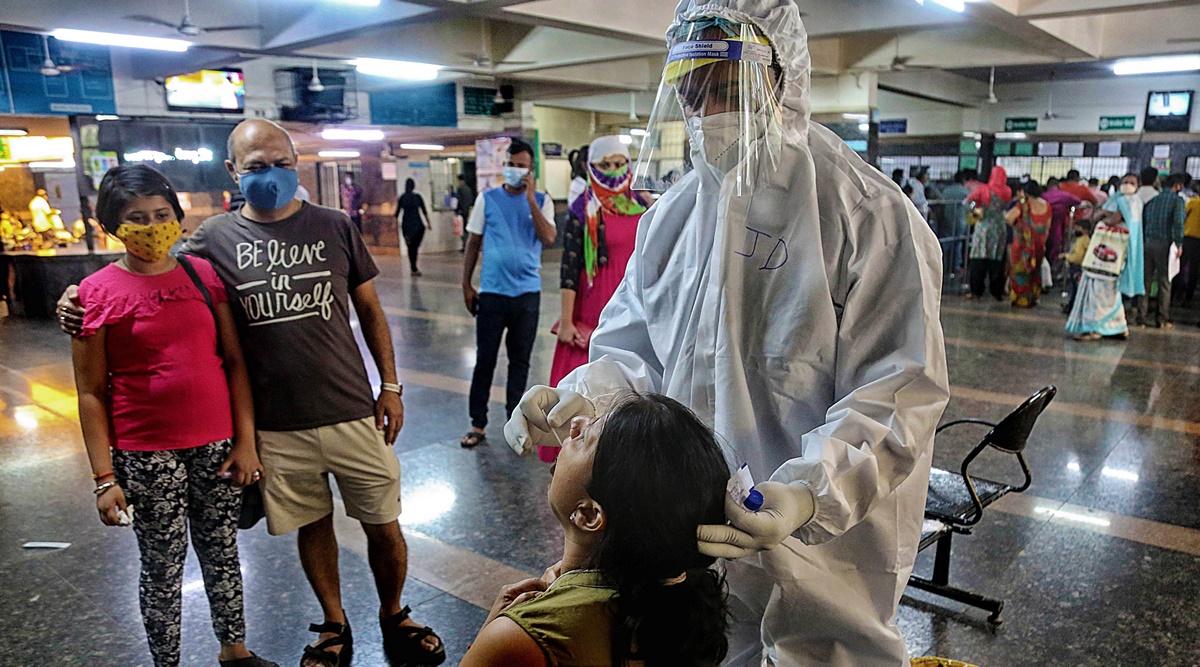 India reported 46,951 cases in a single day on March 22. (Express file)
India reported 46,951 cases in a single day on March 22. (Express file) On March 25 last year, Prime Minister Narendra Modi had announced a nationwide lockdown in view of the rising number of Covid-19 cases. Almost a year later, India is experiencing a renewed surge in infections with many states reportedly in the grip of a second wave.
Starting from January last year, when the first case of Covid-19 was detected in India to administering over 32 lakh vaccine doses, the country has come a long way while dealing with the crisis.
Here is a timeline of events and where we stand now in our fight against the pandemic:
December 31, 2019: China alerts WHO of 27 cases of “viral pneumonia” in Wuhan. Authorities shut down a wet market in Wuhan the next day, after discovering some patients were vendors or dealers.
January 11, 2020: After a 61-year-old man succumbs to the infection, lab reports cited by Chinese state media point to a new type of coronavirus.
January 13: A Chinese woman is quarantined in Thailand, making it the first detection of the virus outside China.
January 15: Japan confirms its first case.
January 20: Five days after Japan detected the first patient, South Korea confirms its first case.
January 22: WHO convenes an emergency meeting. However, Director-general Tedros Adhanom Ghebreyesus says the new coronavirus does not yet constitute an international emergency.
January 23: China issues a lockdown for millions of people in Wuhan and Hubei province as the death toll rises to 18.
January 24: The first cases of coronavirus in Europe are reported in France.
January 30: India’s first Covid-19 patient — a 20-year-old medical student who just came back from Wuhan in China — reported in Kerala’s Thrissur district.
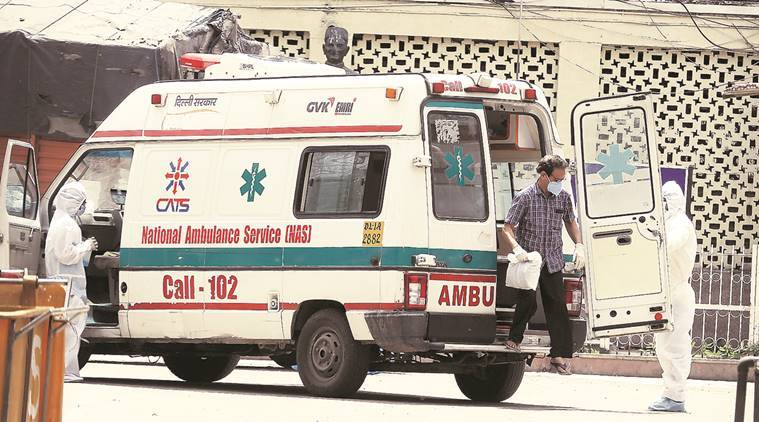 A 20-year-old medical student who just came back from Wuhan in China was India’s first Covid patient. (Representational image)
A 20-year-old medical student who just came back from Wuhan in China was India’s first Covid patient. (Representational image)
On the same day, WHO says the crisis is a global emergency of international concern as the death toll in China jumps to 170, with 7,711 cases reported in the country. More than 7,500 cases were reported in 20 countries of the world.
February 1: The second evacuation flight approved by China. The plane lands at 8 pm, and takes off with 323 Indians and seven Maldives nationals at 6 am on February 2.
February 3: Kerala government declares coronavirus a state calamity after two more cases were reported in Alappuzha and Kasaragod district.
February 4: India cancels existing visas for Chinese and foreigners who had visited China in the last two weeks as the death toll in China exceeds that of the 2002-03 SARS outbreak. About 3,711 people, including 138 Indians, were quarantined aboard the Diamond Princess cruise ship docked in Japan after a passenger, who had disembarked at Hong Kong, are found to be infected with the virus.
February 11: WHO announces that the disease caused by novel coronavirus will be called ‘Covid-19’. The new coronavirus was named SARS-CoV-2.
February 19: Test results of India’s first Covid-19 patient come negative and she is discharged from the Thrissur Medical College Hospital.
March 2: Two more cases detected outside Kerala reported – a 45-year-old man in Delhi who had travelled back from Italy and a 24-year-old engineer in Hyderabad who had a travel history from Dubai.
March 10: A total of 50 Covid-19 cases reported in India, with infections doubling in just 4 days. Thirteen states and UTs in India have reported at least one Covid-19 case.
March 11: WHO declares Covid-19 a pandemic, which is defined “an epidemic that has spread over several countries or continents, and most people do not have immunity against it”. At this point, more than 1,21,000 people were infected and over 4,300 died globally. US blocks visitors from Europe.
March 12: India reports first fatality due to Covid-19 after a 76-year-old man from Kalburgi, Karnataka, dies. India also bans entry of foreigners and suspends all visas from March 13 to April 15.
March 15: Total number of Covid-19 cases touches 100 as Maharashtra overtakes Kerala with maximum infections. CDC recommends no gatherings of 50 or more people in the US.
March 22: Upon a call by Prime Minister Narendra Modi, a 14-hour voluntary lockdown called ‘Janata Curfew’ was observed in India. Prime Minister Boris Johnson imposes lockdown in Britain.
March 25: A nationwide lockdown across India is imposed till April 14, with only essential services kept out of its purview. Tokyo Olympics postponed for a year until 2021.
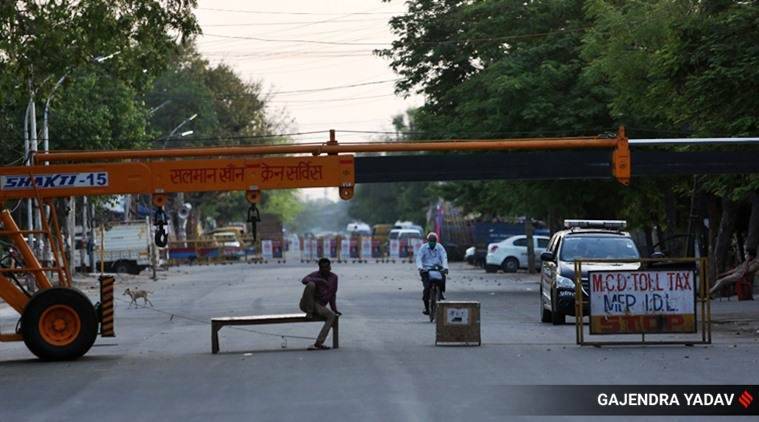 A nationwide lockdown across India was imposed on March 25 last year. (Express file)
A nationwide lockdown across India was imposed on March 25 last year. (Express file)
March 26: On the second day of the lockdown, India witnesses migrant labourers walking hundreds of kilometres along highways to reach their native villages.
Finance Minister Nirmala Sitharaman announces a Rs 1.7 lakh crore package under a new scheme called the Pradhan Mantri Gareeb Kalyan Yojana (PMGKBY) to address the economic distress. The package includes free food to the “poorest of the poor”, income support to farmers and unorganised sector workers.
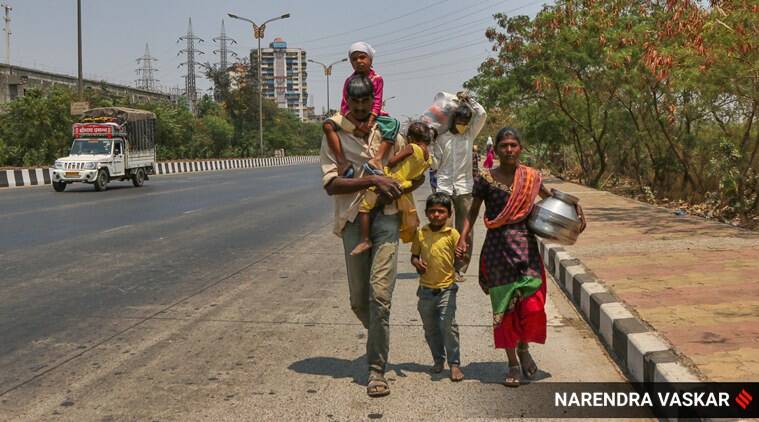 Migrant workers walked thousands of kilometres after the lockdown was imposed. (Express file)
Migrant workers walked thousands of kilometres after the lockdown was imposed. (Express file)
March 27: RBI announces a three-month moratorium (March 1 to May 31) on loan and card repayments and slashed its main policy rate — repo rate by 75 basis points and cash reserve ratio (CRR) of banks by 100 basis points to stabilise the financial markets and reduce the pain on borrowers hit by Covid-19 pandemic.
March 30: Nizamuddin Markaz, which is the international headquarters of Tabilghi Jamaat, emerges as a Covid-19 hotspot, with authorities saying around 5,000 are being traced across the country.
 Nizamuddin Markaz, which is the international headquarters of Tabilghi Jamaat, emerged as a Covid-19 hotspot. (Express file)
Nizamuddin Markaz, which is the international headquarters of Tabilghi Jamaat, emerged as a Covid-19 hotspot. (Express file)
April 5: Upon PM Modi’s call, citizens light diyas, candles, torches and flashlights to show solidarity with Covid-19 frontline healthcare workers.
April 6: The death toll in India crosses the 100-mark.
April 14: Prime Minister Modi extends the 21-day lockdown to May 3. 10,000 confirmed cases are recorded. MHA issues “National Directives” for COVID-19 management, makes wearing a face cover mandatory in work and public spaces.
April 29: India records 1,000 confirmed deaths.
May 1: Home Ministry extends lockdown for two weeks starting May 4 with zone-wise restrictions. Divides districts into red, orange and green zones on the basis of cases. Shramik Special trains started for stranded migrant workers.
May 7: Phase 1 of Vande Bharat mission to evacuate nearly 15,000 Indians stranded abroad begins. 50,000 confirmed cases reported in India.
May 12: PM Narendra Modi announces Rs 20 lakh crore Atmanirbhar package, says size is 10% of GDP, including announcements made by RBI earlier.
May 13: Finance Minister Nirmala Sitharaman announces Tranche 1 of Atmanirbhar package of Rs 5.94 lakh crore (2.97% of GDP). It includes collateral free automatic loans to MSMEs, 100% credit guarantee cover to banks, NBFCs worth Rs 3 lakh crore, subordinate debt to stressed MSMEs worth Rs 20,000 crore, equity infusion for MSMEs worth Rs 50,000 crore and EPF support for 3 months worth Rs 2,500 crore.
May 14: Finance Minister Nirmala Sitharaman announces Tranche 2 of Atmanirbhar package of Rs 3.10 lakh crore (1.55% of GDP). It includes free food grain supply to migrants for 2 months worth Rs 3,500 crore and special liquidity scheme to provide Rs 10,000 working capital to 50 lakh street vendors at Rs 5,000 crore.
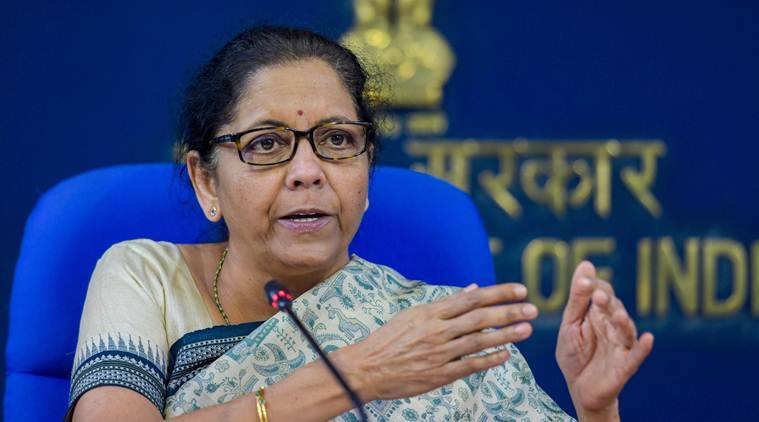 On May 14, Finance Minister Nirmala Sitharaman announced the Tranche 2 of Atmanirbhar package of Rs 3.10 lakh crore. (PTI photo)
On May 14, Finance Minister Nirmala Sitharaman announced the Tranche 2 of Atmanirbhar package of Rs 3.10 lakh crore. (PTI photo)
May 15: Finance Minister Nirmala Sitharaman announces Tranche 3 of Atmanirbhar package of Rs 1.5 lakh crore (0.75% of GDP). It includes financing facility for agri infra projects worth Rs 1,00,000 crore. Besides, govt decides to formulate a central law that will not bind farmers to sell crop only to licensed traders in the APMC mandis.
May 16: Finance Minister Nirmala Sitharaman announces Tranche 4 of Atmanirbhar package of Rs 8,100 crore (0.04% of GDP). Major policies include hiking of defence FDI to 74% from 49% and viability gap funding (VGP) for social infrastructure.
May 17: MHA extends lockdown till May 31, allows inter-state movement of passenger vehicles, buses with mutual consent of states. With nearly 86,000 cases, India overtakes China in terms of the total number of cases reported.
Finance Minister Nirmala Sitharaman announces Tranche 5 of Atmanirbhar package of Rs 40,000 crore (0.2% of GDP). Limit of state borrowings increased to 5% from 3% of GSDP, MGNREGA gets additional Rs 40,000 crore.
May 19: Total Covid-19 cases in India cross 1 lakh.
May 25: Domestic flight services resume in a calibrated manner, with only 30% of regular schedules.
June 5: WHO changes its guidelines on using face masks, advising that face masks should be worn in public to stop the spread of Covid-19.
June 8: Phased reopening begins, with Unlock 1.0 guidelines coming into force, as India records more than 2,50,000 COVID-19 cases and 7200 deaths. Centre allows re-opening of malls, hotels, restaurants and places of worship.
June 12: India overtakes UK to become 4th worst coronavirus-hit country, with over 3 lakh cases.
June 13: Health Ministry includes loss of the sense of smell and taste among the symptoms of Covid-19.
June 27: Total cases cross 5 lakh. After reporting 100,000 cases on May 19, India adds 100,000 cases in 15, 10, 8 and 5 days respectively to bring the total number of cases to half a million.
July 1: Unlock 2.0 guidelines come into force, with relaxations in night curfew, provision for more domestic flights and trains, and clearance for more than five people in a shop.
July 6: India overtakes Russia to become third worst coronavirus-hit country, with 6.97 lakh cases. The US had more than 28 lakh cases, while Brazil had close to 16 lakh.
July 8: WHO acknowledges “evidence emerging” of the airborne spread of the novel coronavirus besides transmission through respiratory droplets.
July 15: Phase-1 clinical trials of India’s first indigenous Covid-19 vaccine, Covaxin, developed by Hyderabad-based pharmaceutical company Bharat Biotech in collaboration with the National Institute of Virology and Indian Council of Medical Research, starts across the country.
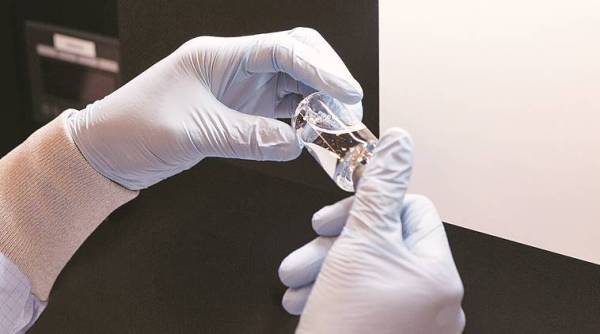 Covaxin was developed by Hyderabad-based pharmaceutical company Bharat Biotech in collaboration with the National Institute of Virology and Indian Council of Medical Research
Covaxin was developed by Hyderabad-based pharmaceutical company Bharat Biotech in collaboration with the National Institute of Virology and Indian Council of Medical Research
July 17: International commercial flights resume as India establishes individual bilateral bubbles with France and the US. India’s total Covid-19 cases cross 10 lakh. Death toll stands at 25,600.
July 25: BCCI announces Indian Premier League to start on September 19 in the United Arab Emirates (UAE) with the final slated on November 8.
August 1: Phase 3.0 of Unlock comes into force, with govt allowing gymnasiums and yoga centres to function, and revoking the night curfew order.
August 11: Russia becomes first country to grant regulatory approval to a Covid-19 vaccine, dubbed “Sputnik V”, for civilian use, claims President Vladimir Putin. Development raises doubts among global scientific community as approval comes before Phase III trials.
August 22: The Indian Council of Medical Research reports more than one million diagnostic tests for Covid-19, with India overtaking Russia in terms of total number of samples tested till now. With 34.5 million tests having conducted till now, India ranks third in the world. Only China (90.4 million) and the United States (74.7 million) tested more.
August 26: Serum Institute of India starts India trials of Covishield, the University of Oxford-AstraZeneca vaccine candidate, with two volunteers in Pune’s Bharati Vidyapeeth Medical College receiving the first shots.
August 11: Russia becomes first country to grant regulatory approval to a Covid-19 vaccine, dubbed “Sputnik V”, for civilian use, claims President Vladimir Putin. Development raises doubts among global scientific community as approval comes before Phase III trials.
August 22: The Indian Council of Medical Research reports more than one million diagnostic tests for Covid-19, with India overtaking Russia in terms of total number of samples tested till now.
August 26: Serum Institute of India starts India trials of Covishield, the University of Oxford-AstraZeneca vaccine candidate, with two volunteers in Pune’s Bharati Vidyapeeth Medical College receiving the first shots.
September 7: India overtakes Brazil to emerge as the country with the second largest number of people infected with novel coronavirus, recording 41.13 lakh confirmed infections.
Metro services resume in a graded manner across the country as per Union Home Ministry’s Unlock-4 guidelines. Commercial metro services had stopped on March 24.
September 10: Serum Institute of India halts clinical trials of the Covid-19 vaccine candidate developed by University of Oxford as AstraZeneca pauses global trials after one participant develops a “potentially unexplained illness”.
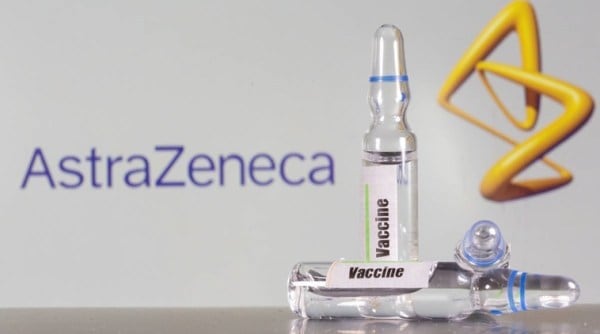 Serum Institute of India halted clinical trials of the Covid-19 vaccine candidate developed by University of Oxford as AstraZeneca pauses global trials after one participant developed a “potentially unexplained illness”.
Serum Institute of India halted clinical trials of the Covid-19 vaccine candidate developed by University of Oxford as AstraZeneca pauses global trials after one participant developed a “potentially unexplained illness”.
September 12: India breaks its own record in fresh Covid-19 cases, records another highest single-day spike in infections, with 97,570 people found coronavirus positive in 24 hours.
September 14: The 18-day monsoon session of Parliament kicks off under the shadow of the Covid-19 pandemic, with Lok Sabha and Rajya Sabha members occupying seats in both Houses to ensure social distancing. More than two dozen MPs belonging to various parties tested positive, sources confirmed.
September 16: The number of confirmed cases of novel coronavirus crossed the five million (50 lakh) mark on Tuesday, with the addition of more than 90,123 new detections. The last one million cases have been added in just 11 days. India closes gap with the US, which has 6.8 million cases (68.77 lakh) so far.
Hyderabad-headquartered drugmaker Dr Reddy’s Laboratories (DRL) enters into an agreement to help conduct Phase III human trials of Russia’s Sputnik V Covid-19 vaccine in India. Firm to distribute up to 100 million doses for “mass vaccination” in the country.
September 17: The number of active cases of novel coronavirus in the country crossed the one million (ten lakh) mark on Wednesday. These are the people who are yet to recover from the disease, and thus require medical attention, and are also the ones who can spread the infection.
September 19: DGCI approves country’s first Clustered Regularly Interspaced Short Palindromic (CRISPR) Covid-19 test for commercial launch. Jointly developed by Council of Scientific and Industrial Research (CSIR) and Tata Group, the test has been named ‘Feluda’.
September 21: After remaining shut for the past six months, schools partially reopened in several states to enable students studying in Classes 9 to 12 to visit their institutions on a voluntary basis for taking guidance from their teachers.
September 22: India reports over 1 lakh coronavirus recoveries in a single-day for the first time, improving the recovery rate to 80.86 per cent. Heath Ministry data shows 1,01,468 Covid-19 patients recuperated.
September 23: Minister of State for Railways Suresh Chanabasappa Angadi became the first Union minister to succumb to the coronavirus. Angadi, 65, passed away less than two weeks after he was admitted to the All India Institute of Medical Sciences (AIIMS) on September 11 with symptoms of Covid-19.
September 27: India’s Covid-19 tally goes past 60 lakh, with total recoveries crossing the 50 lakh milestone. The rise in the number of total recovered cases from 1 lakh in June 2020 has been steep and the last 10 lakh recoveries were added in just 11 days, the Health Ministry said.
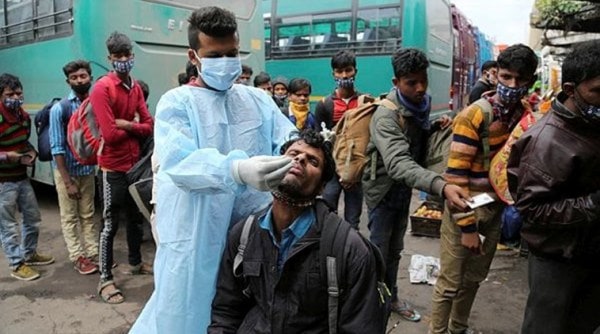 India’s Covid-19 tally went past the 60 lakh-mark on September 25 last year. (PTI photo)
India’s Covid-19 tally went past the 60 lakh-mark on September 25 last year. (PTI photo)
September 28: The global death count from Covid-19 crosses one million, taking just three months to double from half a million. The total number of Covid-19 cases across the world has crossed 33 million, while nearly 23 million people have recovered.
September 29: Global deaths due to Covid-19 exceed 1 million.
September 30: MHA issues Unlock 5.0 guidelines, allows cinemas and multiplexes to open with 50 per cent capacity from October 15. It says states and Union Territories can take a decision on whether to open schools; removes limits on outdoor gatherings while allowing indoors gatherings with 50 per cent capacity.
December 2: UK becomes the first country to give emergency use authorisation to Pfizer-Biontech’s coronavirus vaccine for public use. December 19, 2020: India’s coronavirus numbers cross 1 crore-mark.
December 19: India’s coronavirus numbers cross 1 crore-mark.
December 7, 2020: SII and Bharat Biotech applied for emergency use authorisation for their respective vaccines.
December 19, 2020: India’s Covid-19 tally crosses 1 crore-mark.
UK announces that a new variant strain of the virus has been detected that can spread more quickly. The new strain could be up to 70% more transmissible and is driving the rapid spread of infections, UK Prime Minister Boris Johnson says.
December 28: Centre conducts a dry-run across four states – Punjab, Assam, Andhra Pradesh, and Gujarat, before the vaccination exercise can commence.
2021
January 2, 2021: India conducts first nationwide dry run for all states and Union Territories.
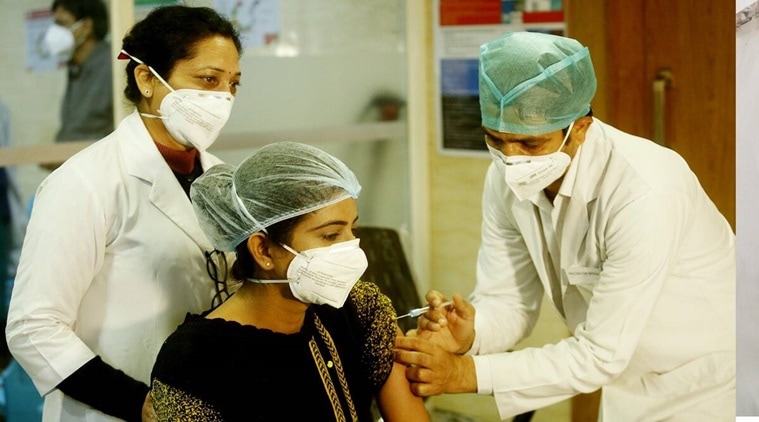 India conducted a nationwide vaccine dry run on January 2. (Express file)
India conducted a nationwide vaccine dry run on January 2. (Express file)
January 3: DCGI approves Bharat Biotech’s vaccine candidate Covaxin for restricted usage in emergency situations in India, a day after Serum Institute of India’s vaccine candidate got the approval for emergency use.
January 8: India conducts second nationwide dry run in all states and UTs.
January 11: The government places a purchase order with Serum Institute of India (SII) for 11 million doses of Oxford Covid-19 vaccine, Covishield.
January 12: The first consignment of Covishield leaves for Delhi, four days ahead of the nationwide inoculation drive launch.
January 13: First consignment of Covaxin dispatched from Hyderabad.
January 16: India begins one of the world’s biggest coronavirus vaccination programmes.
January 20: India starts exporting Covid vaccines with the first shipment to the neighbouring Himalayan kingdom of Bhutan.
January 21: India hands over 2 million doses of vaccines to Bangladesh under grant assistance.
January 22: Two flights, each carrying two million doses of Covishiel, depart from the Mumbai airport for Brazil and Morocco. Sri Lanka approves the emergency use of Covishield. By this time, India is sending vaccines under grant assistance to the Maldives, Bangladesh, Nepal, Myanmar and Seychelles.
January 28: The Ministry of External Affairs says that India has gifted over 55 lakh doses of Covid-19 vaccines to its neighbouring countries.
February 5: A total of 7,580 adverse events following immunisation reported till January 31, says Health Minister Harsh Vardhan.
February 7: With over 53 lakh people getting the jab, India third on list of most vaccine doses administered. US and UK remain ahead of India.
February 13: The second dose of vaccination starts for those who had completed 28 days since receiving their first dose of the shot.
February 19: India completes one crore vaccinations in 34 days, becoming the second-fastest in the world after the United States.
February 23: The Union health ministry reveals that two new strains of Covid-19 have been detected in India. The Centre says 187 people have tested positive for the UK strain, six people detected with the South African strain and one with Brazilian strain in India. It adds that after a brief lull, the variant strains may be pushing up the number of infections once again.
March 1: Second phase of vaccination drive begins. All people above the age of 60 and those between 45 and 59 with specific comorbidities are eligible. People can now register on the Co-Win 2.0 portal.
Prime Minister Narendra Modi takes his first dose of the vaccine.
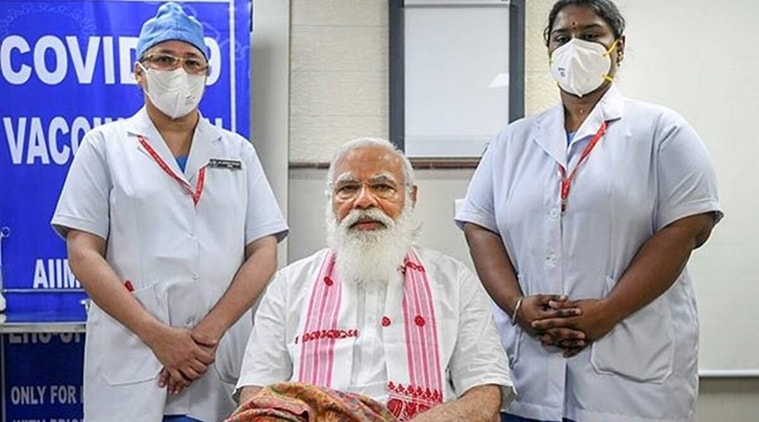 PM Narendra Modi after receiving the first dose of the Covid vaccine. (PTI photo)
PM Narendra Modi after receiving the first dose of the Covid vaccine. (PTI photo)
March 6: Union Health Secretary Rajesh Bhushan and NITI Aayog member Dr V K Paul, who heads the national task force on Covid-19, holds a video-conference with officials of Haryana, Andhra Pradesh, Odisha, Goa, Himachal Pradesh, Uttarakhand and the Union Territories of Delhi and Chandigarh amid reports of a surge in the number of infections.
March 15: India crosses the milestone of 3.15 crore vaccinations.
March 17: Amid reports of rising number of Covid cases, Prime Minister Narendra Modi holds a meeting with chief ministers through video-conferencing and called for quick and decisive steps to curb the spread of the virus.
Modi said the emerging second peak of Coronavirus should be stopped immediately. He further asked the CMs to take the issue of wastage of vaccine doses seriously.
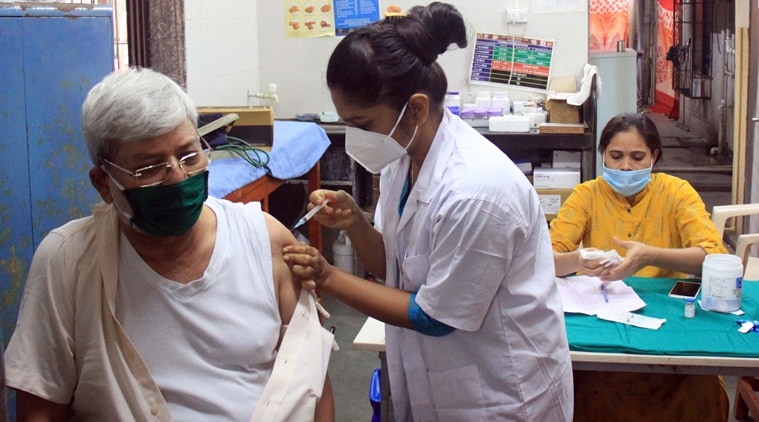 Even as the vaccination programme is underway, India has been witnessing a surge in the number of Covid-19 cases. (Express photo by Deepak Joshi)
Even as the vaccination programme is underway, India has been witnessing a surge in the number of Covid-19 cases. (Express photo by Deepak Joshi)
March 21: Maharashtra reports 30,535 cases in a single day.
March 22: India reports 46,951 cases in a single day — the highest spike since November.
More than 32.53 lakh vaccine doses administered, the highest single-day vaccination so far, taking the total number of people inoculated to over 4.8 crore.
March 23: Government announces that everybody above the age of 45 will be eligible for vaccination from April 1.
Punjab Chief Minister Captain Amarinder Singh says 81 per cent of the latest 401 samples sent by the state for genome sequencing have turned up positive for the new UK Covid variant.